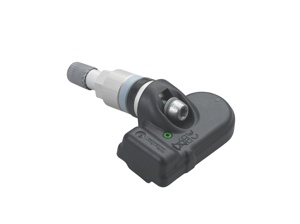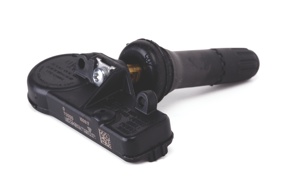 As a former installer who has dealt with the incredibly wide range and variety of OE tire pressure sensors that shops need to cover, using one of the newest aftermarket systems that can cover the vast majority of the market with only a few sensors just makes a lot of sense to me.
As a former installer who has dealt with the incredibly wide range and variety of OE tire pressure sensors that shops need to cover, using one of the newest aftermarket systems that can cover the vast majority of the market with only a few sensors just makes a lot of sense to me.
Especially now that the non-replaceable batteries on many first-generation sensors are beginning to fail in ever-larger numbers, it’s going to be ever more important than ever to have an easy way to replace sensors without having to keep large inventories on hand or searching suppliers for just the right sensor for an impatient customer.
But which solution is right for your shop? Let’s take a look at what’s available.
Current OE replacement solutions fall into one of two categories: preprogrammed and programmable.
Pre-programmed sensors are essentially OE-like sensors with many vehicle protocols built-in, so that a few SKUs can cover most applications. The major advantage of pre-programmed sensors is that new tools or procedures are unnecessary. The sensor simply follows standard relearn procedures as if it were a true OE sensor.
Programmable sensors are blank until written over with the correct vehicle data, which requires an extra programming tool. The advantage here is that although two or three sensors are initially required by either type to cover the 315Mhz and 433Mhz radio bands, pre-programmed systems must build new SKUs to expand their coverage, while programmable systems will update faster and require fewer SKUs in the long term.
Dill Air Controls Redi-Sensor:
Dill Air Control’s Redi-Sensor solution achieves 87% coverage with three pre-programmed SKUs. Brian Rigney, general manager at Dill Air Controls, notes that, “Redi-Sensor is made with OE components and tested to OE standards,” including high-quality anodized alloy to resist corrosion. “The valve stem can be removed. Also, the valve stem is adjustable, meaning it can fit a wide variety of OE and aftermarket wheels. This is a very important feature. We also offer a rubber valve option.”
Presently, Dill offers four SKUs, with a sensor finding application at www.dillvalves.com:
• 7001HP – 315 Mhz, covering GM, Chrysler, Ford, Nissan Infiniti, Suzuki, Mitsubishi, Volvo, Mazda and more.
• 7001HPR – The same as 7001HP, but with a snap-in rubber valve.
• 7002 – 315 Mhz, covering Asian vehicles not on 7001HP
• 7004 – 433 Mhz, covering Volvo, Chrysler, Dodge and Jeep.
Future modules are in the works to expand coverage still farther, Rigney says. “The goal is to effectively group the remaining protocols plus any new sensor designs,” he says.
Oro-Tek:
Oro-Tek’s solution is three pre-programmed sensors that together cover 90% of the market. Oro-Tek’s sensors have a replaceable metal valve stem on a two-piece design that allows the sensor to be adjusted laterally to fit the wheel’s drop well. Application lists can be found at www.orotekusa.com.
SKUs include:
• OTI-001 – 315Mhz, covering 70% of the total vehicle market.
• OTI-002 – 433Mhz including 2006-12 BMW.
• OTI-003 – 315Mhz, covering most Asian imports.
Myers Sens.it:
Developed by Alligator Ventilfabrik and distributed by Myers Tire Supply, the Sens.it uses three programmable SKUs to achieve 95% vehicle coverage.
A tire tech can enter the VIN or the sensor serial number into a web application, and sensor data is downloaded and written to the sensor by the specialized Alligator tool. If the tire is replaced in the same position, there is generally no need for relearn procedures. The web application is updated constantly with no annual update fees, and can track statistics for models serviced. A coverage list is available at web.alligator-sensit.com.
Stuart Ferguson, president of Alligator North America, says, “We believe that our solution makes the most sense because it provides the best coverage with the lowest logical inventory. Most claims from our competitors regarding vehicle coverage relate only to the software availability, but do not include the mechanical fit to the vehicle. The fit to the vehicle includes valve type (rubber snap-in and metal clamp in) and color – black, silver, grey etc.
“Since we have been selling both a snap-in solution and a metal stem solution for the past three years, our records show 40% of TPMS services are carried out using a snap-in and 60% using a metal stem part. If a supplier states that they have 90% coverage, but only offer a metal stem part, then the actual coverage is really closer to 50%. Also, to fit all wheel rim profiles (OE and replacement), the metal valve has to have an adjustable angle.”
Sens.it 315Mhz sensors are currently available with rubber or metal valve stems, while the 433Mhz sensors are only available with metal stems.
Alligator uses high-grade anodized aluminum, “the same grade as is used on submarine periscopes” in their metal stems to resist corrosion, as well as an interesting plastic washer integrated with the valve stem to prevent metal to metal contact. The sensors are compatible with all standard TPMS tools.
Ferguson notes, “As part of our ongoing development we have been testing the valve portion of competitive parts to normal OE standards. Of greatest concern are the new rubber snap-in products, which were introduced to the market this year. These parts failed when subjected to basic OE tests, such as high speed and deflection tests. While most rubber valve stems look the same, there is a huge difference in materials, material properties and engineering that go into these. Much of the cost-saving associated with the ‘cheaper’ products are achieved by cutting corners which should not be cut.”
Schrader EZ-Sensor: Developed by Schrader and Bartec, the EZ-Sensor consists of two programmable sensors that together cover more than 85% of the market. The 315 Mhz and 433Mhz Schrader sensors are blank until cloned by a special TPMS tool which writes the proper vehicle information.
Developed by Schrader and Bartec, the EZ-Sensor consists of two programmable sensors that together cover more than 85% of the market. The 315 Mhz and 433Mhz Schrader sensors are blank until cloned by a special TPMS tool which writes the proper vehicle information.
Sensors can be rewritten multiple times, and will follow relearn procedures with standard TPMS tools once cloned. The EZ-Sensor features a two-part design with a rubber snap-in valve stem that can be easily removed and replaced, eliminating the corrosion issues suffered by metal stems. Schrader does offer sensors with metal valve stems as well.
More information can be found at www.ez-sensor.com.
Bartec updates their vehicle database quarterly for an annual fee.
Paul Wise, director of product management and marketing at Schrader, says, “As new vehicles with new vehicle protocols enter the market, tire dealers can simply download new software onto their existing hand-held tool. For the aftermarket, this results in an infinitely scalable solution – minimizing the need for additional inventory and ensuring that repair centers can meet the TPMS needs of virtually any vehicle.”
Cloning can be performed by one of the many tools now available:
Schrader’s 21220, 21230 and 21240 TPMS tools can copy broken sensors or retrieve vehicle information from the database and clone to an EZ-Sensor. They have scan, relearn and OBD functionality, and can download and print sensor audit information via a computer connection.
Bartec’s Tech200 and Tech300 lines are able to copy and write EZ-Sensors in addition to being full-functioned scan and relearn tools.
The Bartec TPMS pad connects to a desktop or laptop and makes cloning sensors as easy as laying the broken sensor on the pad to read it, then laying the blank sensor on the pad to write it.
Or the software can look up sensor information by make or VIN.
It is the Bartec Tech400 and Tech500 tools that take the next step forward. The Tech400 can clone both EZ-Sensors and Myers’ Sens.it and other sensors by Echlin and Standard Motor Products. The Tech500 can reprogram all those sensors and many more, including sensors from 31 Inc., Orange Electronics, ITM, Pilot TPMS and Huf. It also stores a database of relearn procedures onboard, tests keyless entry transmitters, records printable audit reports, allows OBD access and can be updated via wireless or Bluetooth. Sadly it neither whistles Dixie nor dispenses Coca-Cola.
Scot Holloway, CEO and general manager at Bartec, told me, “As the market evolved, it was clear that other sensors were emerging, and our customers were looking for options and flexibility. As a result, we have worked very hard to make our tool transparent to the sensor choice. We do not want our tool to be a barrier for our customer’s business decisions.
”Does this strategy change the game? Absolutely,” he says. “Now the installer/technician has options and flexibility in choosing a replacement sensor, how much inventory to keep, and where they can purchase. If this year’s SEMA Show was an indicator (at least three new aftermarket sensors emerged) there will be many more choices for aftermarket sensors. Which means we have our work cut out for us keeping up with changing OE specifications and the proliferation of aftermarket alternatives.”
The variety of options available out on the aftermarket can be confusing, but they also provide some flexibility for shops with different needs.
Smaller shops might opt for the lower entry cost of pre-programmed sensors, while larger shops might look for the higher-volume, long-term flexibility and sheer geek-tech flashiness of programmable systems.
And while it’s always good to have some choices, the companies involved do just keep on leaping ahead, opening up ever newer and more interesting options.













